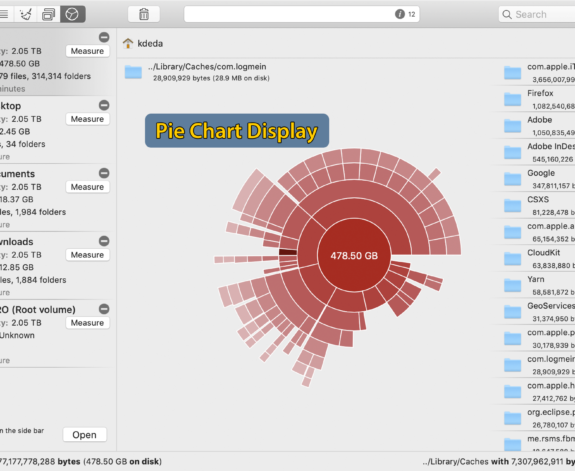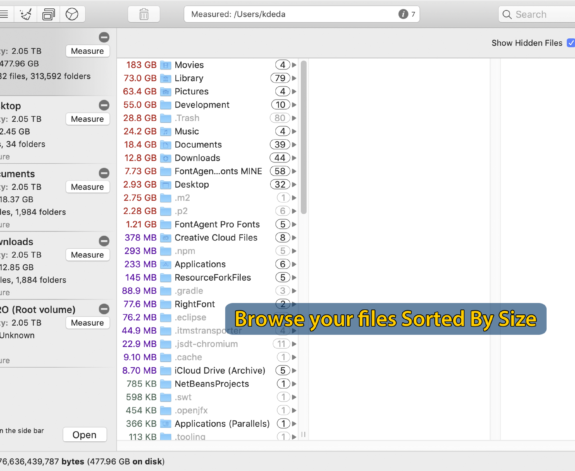WhatSize Speed Up Your Mac System Download
WhatSize for Mac is an application that allows you to quickly view and manage disk space usage and speed up your Mac. WhatSize allows you to quickly measure the disk size in bytes of a given folder and all subfolders and files within it. You would be surprised at how many useless files might be laying around on your hard disks. The files and folders are automatically sorted by size, with the biggest sizes first. This software helps find out what files are taking up all of that space. Then it makes it really easy to remove or move those files. You’d be surprised how many useless files are lying around on your Mac’s hard disk.
While the app is measuring a folder the user can browse the files within that folder and immediately see the size in bytes. Hidden files, cache files, directories will all show up with their corresponding size. This application is similar to the ancient NeXTSTEP, DarkForest.
Once the measuring of a folder has ended the user can also view the information by filtering for particular file sizes or types. The user can also move unwanted files and folders in the corresponding Trash bin similar to the Finder’s Delete button.
 WhatSize automatically detects the available volumes and favorite folders and measures their content in order to highlight the ones that put a serious strain on your storage space. Of course, WhatSize also allows you to manually add new folders to the list.
WhatSize automatically detects the available volumes and favorite folders and measures their content in order to highlight the ones that put a serious strain on your storage space. Of course, WhatSize also allows you to manually add new folders to the list.
It includes a duplicates finder, a delocalized (finds all the language files and allows you to delete the ons you do not need), and a cleaner tool (detects log, download, cache, Nib, localized, and temporary files).
For your convenience, WhatSize offers you the option to delete files and folders as an Administrator, by using the sudo command. However, if you enable this function you must be very careful not to remove items that are critical for the operating system.
Pros And Cons
| Pros | Cons |
| Instantly show the biggest files on your Mac | The demo only catalogs up to 20GB |
| This software includes subfolders | |
| Ability to filter folders | |
| Searches fast |
WhatSize Software To Speed Up Your Mac OS Features
- Measure: What Size for Mac quickly measures the size of your hard drive and allows you to sort, filter, and refine the results. The files and folders are automatically sorted by size with the biggest sizes first. The application will cache measurements for speed and will use Apple’s FSEvents to merge file system changes live.
- Chart Display: A visual display of the contents of your hard drive that enables you to drill down and discover how your disk space is being used.
- Cleaning Tools: Intelligent tools allow you to remove IN ONE CLICK log files, download files, cache files, temporary files, nib files, localization files. Files you do not need or Files the app developers forgot to remove. So you can reclaim disk space and speed up your mac.
- Find Duplicates: Identifies duplicate files on your system so that you can move them to trash, replace them with hard links or simply delete them immediately. Filter by size so you can deal with just the largest files first. Smart caching and FSEvent support allows real-time updates of the duplicates. You would be surprised at how many useless files might be laying around on your hard drive.
Screenshots of WhatSize To Speed Up For Mac System
WhatSize Software Gallery
Video Tutorial of WhatSize For Mac Software
WhatSize Software For PC FAQs
How Are Folder Sizes Calculated?
WhatSize will consider the size of a folder to be the sum of the sizes of all its children.
ad
Why Are The Measured Free Gb’s So Different From Finder.app?
Finder displays the available space on the disk without accounting for the local snapshots. A clean reboot will allow Finder to be more accurate. It displays the size without taking into consideration resource fork data. This software does not properly handle hard links. It is known to count them twice.
ad
What Is A Bit, A Byte, A Kilobyte, A Megabyte, ETC?
– One Bit is literally a zero or one. The smallest amount of info a computer can handle. We represent the file sizes in the app using the following color scheme.
– One B (Byte) = Eight Bits
– One KB (Kilobyte) = 1000 Bytes (2 to the 10th power)
– One MB (Megabyte) = 1000 KB = One CD is around 600 MB
– One GB (Gigabyte) = 1000 MB = One DVD is around 4.5 GB
– One TB (Terabyte) = 1000 GB = One 4K Blu-ray Disc is around 100 GB
ad
Why Is My Brand New 150 GB External Hard Drive Only Showing 139 GB Available?
It’s because drive manufacturers use the decimal system to measure drive capacity (in which 1 GB = 1,000,000,000 bytes, not 1024^3 bytes). Apple switched to using this method in their Snow Leopard release (so in Snow Leopard a 150 GB drive shows up at 150 GB. So this is not an issue when using SnowLeopard and newer.
ad
Why Is My Brand New 150 GB External Hard Drive Only Showing 139 GB Available?
Starting on v7 it use a trusted daemon com.id-design.v7.whatsizehelper and Apple’s Full Disk Access to always measure as Admin. This allows for better tracking of file usage.
ad
I Accidentally Deleted A File. How Can I Recover It?
Open up the Trash in Finder and move the file back to its proper location.
ad
- Treesize
- WizTree
- Baobab Disk Usage Analyzer
- DaisyDisk
- WinDirStat
What’s New In This Version:
WhatSize 7.6.5
– Fixing TimeMachine support for macOS Big Sur
– Maintenance Fixes
WhatSize 7.6.4
– Adding support for macOS Big Sur
– Rare issue that would cause an infinite loop on startup
– It issue related to a mounted volume with missing volume UUID
– Addressed an issue related to improper TimeMachine
WhatSize For Mac Overview
Technical Specification

| Version | 7.6.5 |
| File Size | 20.2 MB |
| Languages | English |
| License | Free Trial |
| Developer | Clyde Deda |
Conclusion
WhatSize is a good tool to have on your Mac if you are running out of storage space and you do not know why. The app measures the disk content, underlines the largest ones, enables you to detect duplicates or unnecessary files, and provides simple tools for removing them in no time. To make sure that certain files and folders remain untouched, you have the option to create an exclusion list. WhatSize enables you to export the current selection to a CSV file.
ad




Comments are closed.